Solar System: Things To Know This Week
Solar System: Things To Know This Week
Weather permitting, you can observe the Moon most nights, unless it’s a new moon, when the lighted side of the Moon faces away from Earth. The Moon is by far the brightest object in the night sky and there’s plenty to see. But this week is special…

…October 28 is International Observe the Moon Night (also known as InOMN).
Here’s all you need to know to join in and celebrate:
1. One Planet. One Moon. One Night.

Everyone on Earth is invited to join the celebration by hosting or attending an InOMN event and uniting on one day each year to look at and learn about the Moon together.
2. What’s Up?

October’s night skies are full of sights, from the first quarter Moon on InOMN to Saturn making a cameo appearance above the Moon October 23 and 24. Watch our What’s Up video for details.
3. Be Social

Hundreds of events are planned around the globe. Click the top link on this page for a handy map. You can also register your own event.
4. Don’t Just Stand There

Here are some activities for enhanced Moon watching.
5. Impress Your Friends with Moon Knowledge

Download InOMN flyers and handouts, Moon maps and even some pre-made presentations. There’s even a certificate to mark your participation.
6. Guide to the Face of the Moon

Almost dead center on the Earth-facing side of the Moon is the Surveyor 6 robotic spacecraft impact side. Apollo 12 and 14 are a bit to the left. And Apollo 11 - the first steps on the moon - are to the right. This retro graphic tells the whole story.
7. Moon Shots

NASA photographers have done some exceptional work capturing views of the Moon from Earth. Here are a few galleries:
You can’t have a solar eclipse without the Moon.
The 2016 “Supermoon” was pretty spectacular.
The Moon gets eclipsed, too.
That IS a Moon - AND the International Space Station.
The Moon is always a great photo subject.
Some spooky shots of the 2014 “Supermoon.”
And 2013.
Tips from a NASA pro for photographing the Moon.
8. Walking on the Moon

Twelve human beings walked on the face of the Moon. Here are some of the best shots from the Apollo program.
9. Moon Watch

Our Lunar Reconnaissance Orbiter is up there right now, mapping the moon and capturing some spectacular high-resolution shots.
10. Keep Exploring

Make our Moon portal your base for further lunar exploration.
Check out the full version of ‘Ten Things to Know This Week’ HERE.
Make sure to follow us on Tumblr for your regular dose of space: http://nasa.tumblr.com.
More Posts from Xyhor-astronomy and Others




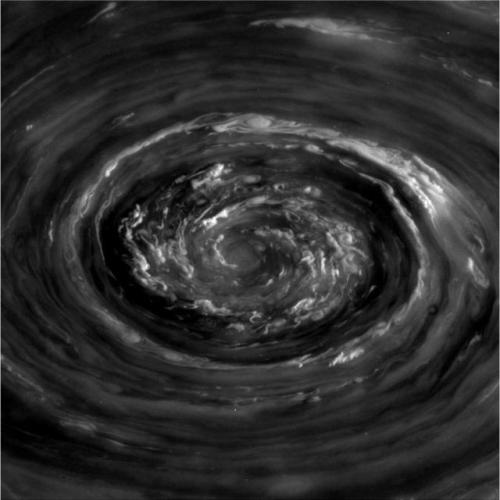
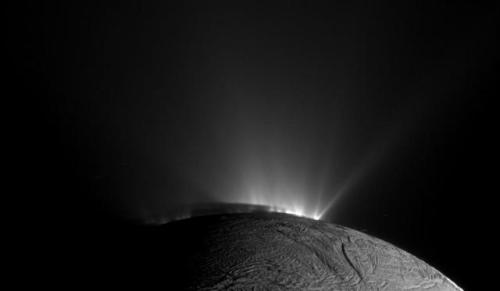

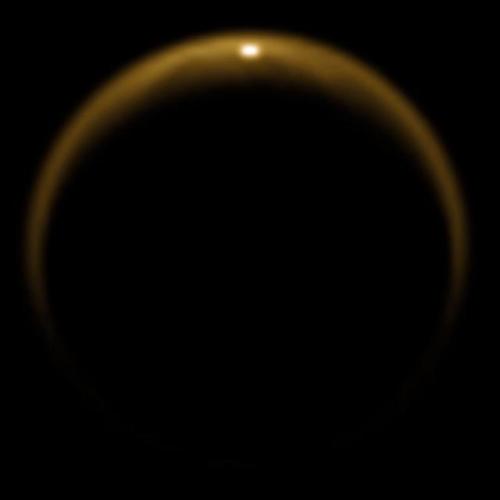

Tomorrow one of the most prolific and beloved spacecraft missions will come to an end when the Cassini spacecraft makes its final plunge into Saturn. After nearly 20 years in space and 13 years orbiting Saturn, the Cassini mission is close to running out of fuel. To prevent the craft from contaminating one of Saturn’s moons – which its mission revealed may harbor the ingredients for life – mission operators are instead sending it on a fatal dive into the gas giant.
Cassini has and will continue to provide a trove of scientific insights about Saturn and its environs. It has given us front-row seats to a storm that wrapped around the entire planet. It shed new light on Saturn’s spectacular hexagonal polar vortex and showed us the beauty of auroras on other planets. Cassini also showed us that Saturn’s moon Titan has stable hydrocarbon lakes at its surface, fed by methane rains and driven by processes unfamiliar to terrestrial ones. It also gave us paths for future exploration by documenting plumes of water ejected from Enceladus’ icebound oceans.
Cassini also holds a special place in my heart. It launched while I was in middle school, reached Jupiter while I was in college, and collected data throughout my postgraduate research career. It was an inspiration for my undergraduate spacecraft mission design projects, and it provided fun and exciting fluid dynamical discoveries throughout my time writing FYFD. It’s my favorite mission (sorry, Mars rovers, New Horizons, Dawn, and Juno!) and likely to remain so for years to come.
So thank you, Cassini, and many thanks to all the scientists, engineers, and operators who’ve worked on the mission during the decades from its conception to completion. You did a hell of a job. Godspeed, Cassini! (Photo credits: NASA/JPL)
P.S. - Tonight I’ll be helping kick off the Ig Nobel Prize ceremony. You can tune into the live webcast here. The ceremony officially starts at 6 PM Eastern time, but I recommend tuning in early, especially if you want to catch my full spiel. - Nicole










The Largest Black Hole Merger Of All-Time Is Coming, And Soon
“Over in Andromeda, the nearest large galaxy to the Milky Way, a number of unusual systems have been found. One of them, J0045+41, was originally thought to be two stars orbiting one another with a period of just 80 days. When additional observations were taken in the X-ray, they revealed a surprise: J0045+41 weren’t stars at all.”
When you look at any narrow region of the sky, you don’t simply see what’s in front of you. Rather, you see everything along your line-of-sight, as far as your observing power can take you. In the case of the Panchromatic Hubble Andromeda Treasury, where hundreds of millions of stars were captured in impressive fashion, background objects thousands of times as distant can also be seen. One of them, J0045+41, was originally thought to be a binary star system that was quite tight: with just an 80 day orbital period. Follow-up observations in the X-ray, however, revealed that it wasn’t a binary star system after all, but an ultra-distant supermassive black hole pair, destined to merge in as little as 350 years. If we build the right observatory in space, we’ll be able to observe the entire inspiral-and-merger process for as long as we like!
Come get the full story, and some incredible pictures and visuals, on today’s Mostly Mute Monday!
The Xpand Your Horizons Family just got bigger! Check out the new pages!
Xpand Your Horizons w/ Paleontology: https://m.youtube.com/playlist?list=PLHFUouhBXdXF6kf0dbsVRghNyDzscVcKc
xyhor-paleontology: https://xyhor-paleontology.tumblr.com
Xpand Your Horizons w/ Archaeology: https://m.youtube.com/playlist?list=PLHFUouhBXdXF6kf0dbsVRghNyDzscVcKc
xyhor-archaeology: https://xyhor-archaeology.tumblr.com
Don’t forget to check out the rest of the family too: https://xpandyourhorizons.tumblr.com/xyhor-family
Solar System: Things to Know This Week
Our Dawn mission to the asteroid belt is no ordinary deep space expedition.
Instead of traditional chemical rockets, the spacecraft uses sophisticated ion engines for propulsion. This enabled Dawn to become the first mission to orbit not one, but two different worlds — first the giant asteroid Vesta and now the dwarf planet Ceres. Vesta and Ceres formed early in the solar system’s history, and by studying them, the mission is helping scientists go back in time to the dawn of the planets. To mark a decade since Dawn was launched on Sept. 27, 2007, here are 10 things to know about this trailblazing mission.
1. Ion Engines: Not Just for Sci-Fi Anymore

Most rocket engines use chemical reactions for propulsion, which tend to be powerful but short-lived. Dawn’s futuristic, hyper-efficient ion propulsion system works by using electricity to accelerate ions (charged particles) from xenon fuel to a speed seven to 10 times that of chemical engines. Ion engines accelerate the spacecraft slowly, but they’re very thrifty with fuel, using just milligrams of xenon per second (about 10 ounces over 24 hours) at maximum thrust. Without its ion engines, Dawn could not have carried enough fuel to go into orbit around two different solar system bodies. Try your hand at an interactive ion engine simulation.
2. Time Capsules

Scientists have long wanted to study Vesta and Ceres up close. Vesta is a large, complex and intriguing asteroid. Ceres is the largest object in the entire asteroid belt, and was once considered a planet in its own right after it was discovered in 1801. Vesta and Ceres have significant differences, but both are thought to have formed very early in the history of the solar system, harboring clues about how planets are constructed. Learn more about Ceres and Vesta—including why we have pieces of Vesta here on Earth.
3. Portrait of a Dwarf Planet

This view of Ceres built from Dawn photos is centered on Occator Crater, home of the famous “bright spots.” The image resolution is about 460 feet (140 meters) per pixel.
Take a closer look.
4. What’s in a Name?
Craters on Ceres are named for agricultural deities from all over the world, and other features carry the names of agricultural festivals. Ceres itself was named after the Roman goddess of corn and harvests (that’s also where the word “cereal” comes from). The International Astronomical Union recently approved 25 new Ceres feature names tied to the theme of agricultural deities. Jumi, for example, is the Latvian god of fertility of the field. Study the full-size map.
5. Landslides or Ice Slides?

Thanks to Dawn, evidence is mounting that Ceres hides a significant amount of water ice. A recent study adds to this picture, showing how ice may have shaped the variety of landslides seen on Ceres today.
6. The Lonely Mountain

Ahuna Mons, a 3-mile-high (5-kilometer-high) mountain, puzzled Ceres explorers when they first found it. It rises all alone above the surrounding plains. Now scientists think it is likely a cryovolcano — one that erupts a liquid made of volatiles such as water, instead of rock. “This is the only known example of a cryovolcano that potentially formed from a salty mud mix, and that formed in the geologically recent past,” one researcher said. Learn more.
7. Shining a Light on the Bright Spots

The brightest area on Ceres, located in the mysterious Occator Crater, has the highest concentration of carbonate minerals ever seen outside Earth, according to studies from Dawn scientists. Occator is 57 miles (92 kilometers) wide, with a central pit about 6 miles (10 kilometers) wide. The dominant mineral of this bright area is sodium carbonate, a kind of salt found on Earth in hydrothermal environments. This material appears to have come from inside Ceres, and this upwelling suggests that temperatures inside Ceres are warmer than previously believed. Even more intriguingly, the results suggest that liquid water may have existed beneath the surface of Ceres in recent geological time. The salts could be remnants of an ocean, or localized bodies of water, that reached the surface and then froze millions of years ago. See more details.
8. Captain’s Log
Dawn’s chief engineer and mission director, Marc Rayman, provides regular dispatches about Dawn’s work in the asteroid belt. Catch the latest updates here.
9. Eyes on Dawn
Another cool way to retrace Dawn’s decade-long flight is to download NASA’s free Eyes on the Solar System app, which uses real data to let you go to any point in the solar system, or ride along with any spacecraft, at any point in time—all in 3-D.
10. No Stamp Required

Send a postcard from one of these three sets of images that tell the story of dwarf planet Ceres, protoplanet Vesta, and the Dawn mission overall.
Make sure to follow us on Tumblr for your regular dose of space: http://nasa.tumblr.com.
Astronomy and Astrophysics: Facts
Here is a list of some curiosities of astronomy and astrophysics. From our solar system to interstellar space.

Rings of Saturn: With an estimated local thickness of as little as 10 m and as much as 1 km, they are composed of 99.9% pure water ice with a smattering of impurities that may include tholins or silicates. The main rings are primarily composed of particles ranging in size from 1 cm to 10 m.

Valhalla (crater): Valhalla is the largest multi-ring impact crater on Jupiter’s moon Callisto and in the Solar System. It is named after Valhalla, the God Odin’s hall in Norse mythology where warriors are taken after death.

Europa (lineae): Europa’s most striking surface features are a series of dark streaks crisscrossing the entire globe, called lineae (English: lines). Close examination shows that the edges of Europa’s crust on either side of the cracks have moved relative to each other. The larger bands are more than 20 km (12 mi) across, often with dark, diffuse outer edges, regular striations, and a central band of lighter material. The most likely hypothesis states that the lineae on Europa may have been produced by a series of eruptions of warm ice as the Europan crust spread open to expose warmer layers beneath. The effect would have been similar to that seen in Earth’s oceanic ridges.

Tartarus Dorsa: The western part of Pluto’s northern hemisphere consists of an extensive, highly distinctive set of 500-meter-high mountains informally named Tartarus Dorsa; the spacing and shape of the mountains looks similar to scales or tree bark.

Mountain in Ceres: Ahuna Mons is the largest mountain on the dwarf planet and asteroid Ceres. It protrudes above otherwise smooth terrain, it is not an impact feature, and it appears to be the only mountain of its kind on Ceres. Bright streaks run top to bottom on its slopes; these streaks are thought to be salt, similar to the better known Cererian bright spots, and likely resulted from cryovolcanic activity from Ceres’s interior. It is named after the traditional post-harvest festival Ahuna of the Sumi Naga people of India.

Pluto has a tenuous atmosphere consisting of nitrogen (N2), methane (CH4), and carbon monoxide (CO), which are in equilibrium with their ices on Pluto’s surface. According to the measurements by New Horizons, the surface pressure is about 1 Pa(10 μbar), roughly one million to 100,000 times less than Earth’s atmospheric pressure. It was initially thought that, as Pluto moves away from the Sun, its atmosphere should gradually freeze onto the surface; studies of New Horizons data and ground-based occultations show that Pluto’s atmospheric density increases, and that it likely remains gaseous throughout Pluto’s orbit.

Sagittarius A*: Sagittarius A* is a bright and very compact astronomical radio source at the center of the Milky Way, near the border of the constellations Sagittarius and Scorpius. It is part of a larger astronomical feature known as Sagittarius A. Sagittarius A* is thought to be the location of a supermassive black hole, like those that are now generally accepted to be at the centers of most spiral and elliptical galaxies.

Double Pulsar: PSR J0737−3039 is the only known double pulsar. It consists of two neutron stars emitting electromagnetic waves in the radio wavelength in a relativistic binary system. The two pulsars are known as PSR J0737−3039A and PSR J0737−3039B. It was discovered in 2003 at Australia’s Parkes Observatory by an international team led by the radio astronomer Marta Burgay during a high-latitude pulsar survey.

IC 1101: IC 1101 is a supergiant elliptical galaxy at the center of the Abell 2029 galaxy cluster, approximately 320 megaparsecs (1.04 billion light-years) from Earth. IC 1101 is among the largest known galaxies, but there is debate in the astronomical literature about how to define the size of such a galaxy.

A rogue planet (also termed an interstellar planet, nomad planet, free-floating planet, orphan planet, wandering planet, starless planet, sunless planet, or Planemo) is a planetary-mass object that orbits the galaxy center directly. Such objects have been ejected from the planetary system in which they formed or have never been gravitationally bound to any star or brown dwarf. The Milky Way alone may have billions of rogue planets.
souce: wikipedia
Image credit: NASA/JPL/SwRI, Ted Stryk, John Rowe Animations, commons.wikimedia

Image of Titan taken by the Cassini spacecraft
NASA/JPL-Caltech/SSI/Kevin M. Gill
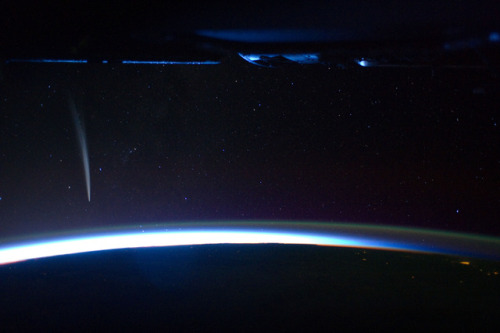
Comet Lovejoy is visible near Earth’s horizon in this nighttime image photographed by NASA astronaut Dan Burbank, Expedition 30 commander, onboard the International Space Station on Dec. 21, 2011.
Image credit: NASA
Secret Chamber? Cosmic Rays Reveal Possible Void Inside Great Pyramid

A large void has been discovered inside the Great Pyramid of Giza, thanks to cosmic rays. If the large space turns out to exist, its function — which could be anything from new chamber to sealed-off construction passage — is likely to be the source of much archaeological debate.
An international group of researchers reported today (Nov. 2) in the journal Nature that by tracking the movements of particles called muons, they have found an empty space more than 98 feet (30 meters) long that sits right above the granite-walled Grand Gallery within the massive pyramid. The Great Pyramid, also known as Khufu’s pyramid, was built during that pharaoh’s reign between 2509 B.C. and 2483 B.C. No new rooms or passages have been confirmed inside the pyramid since the 1800s.
“The void is there,” said Mehdi Tayoubi, the president of the organization Heritage Innovation Preservation and a leader of the ScanPyramids mission, an ongoing effort to bring new technology to bear on Egypt’s most famous structures. Read more.

A false-color image of the mid-infrared emission from the Great Galaxy in Andromeda, as seen by Nasa’s WISE space telescope.
Credit: NASA/JPL-Caltech/WISE Team
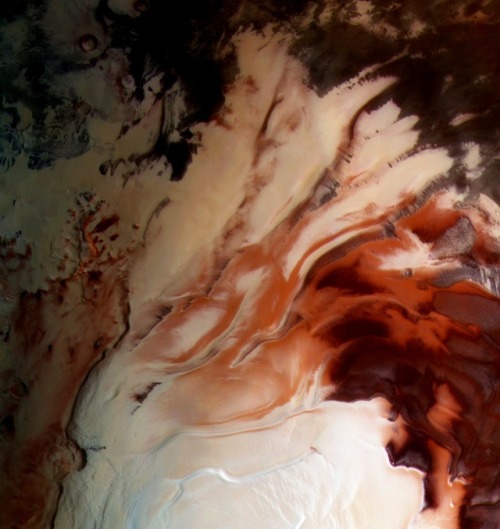
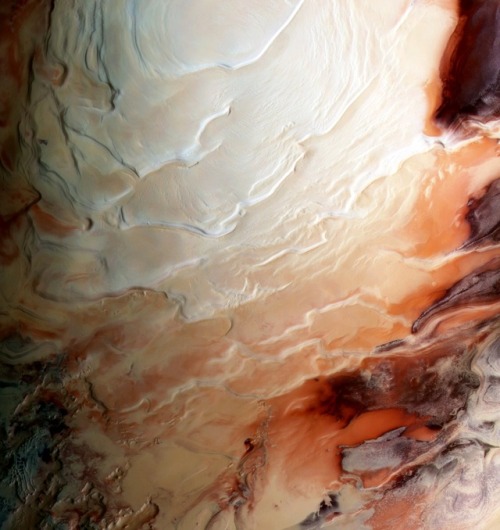
Martian North Pole
ESA / G. Neukum (Freie Universitaet, Berlin) / Bill Dunford
-
 lrfk liked this · 2 months ago
lrfk liked this · 2 months ago -
 espiritucontrito liked this · 7 months ago
espiritucontrito liked this · 7 months ago -
 pptumb liked this · 1 year ago
pptumb liked this · 1 year ago -
 syntheticph liked this · 1 year ago
syntheticph liked this · 1 year ago -
 sweetshire reblogged this · 2 years ago
sweetshire reblogged this · 2 years ago -
 nora-kiev-73 liked this · 3 years ago
nora-kiev-73 liked this · 3 years ago
For more content, Click Here and experience this XYHor in its entirety!Space...the Final Frontier. Let's boldly go where few have gone before with XYHor: Space: Astronomy & Spacefaring: the collection of the latest finds and science behind exploring our solar system, how we'll get there and what we need to be prepared for!
128 posts